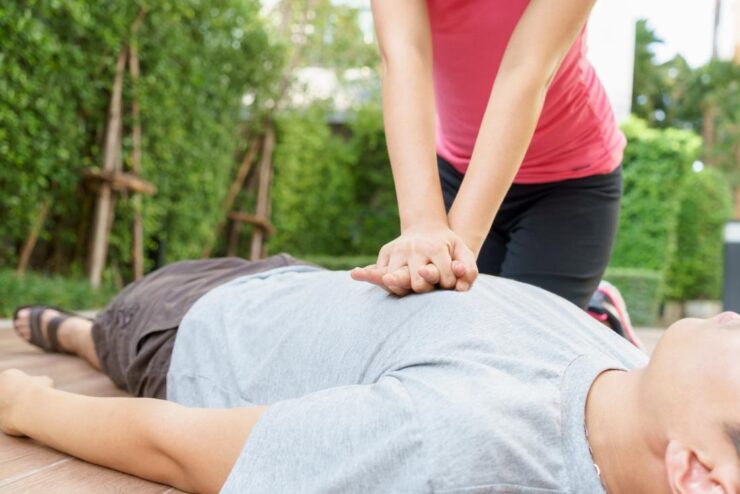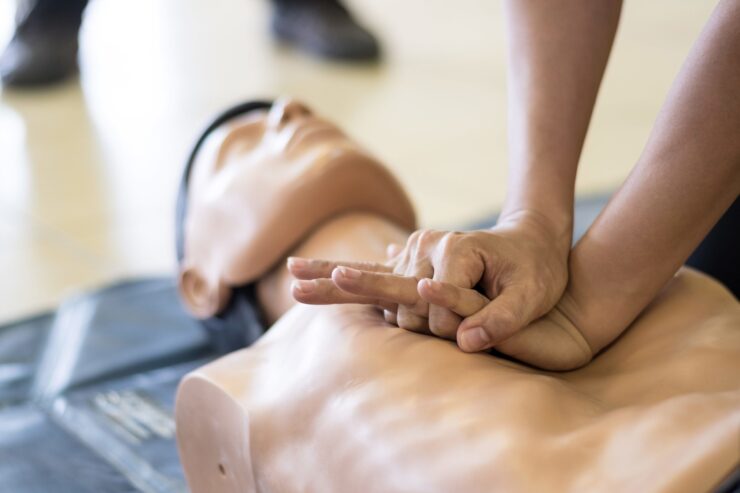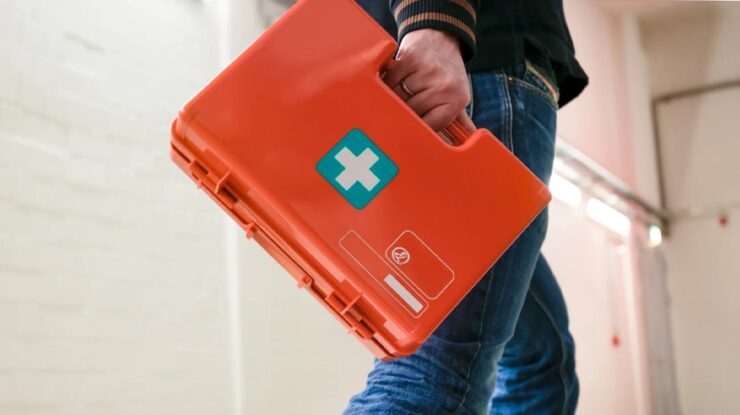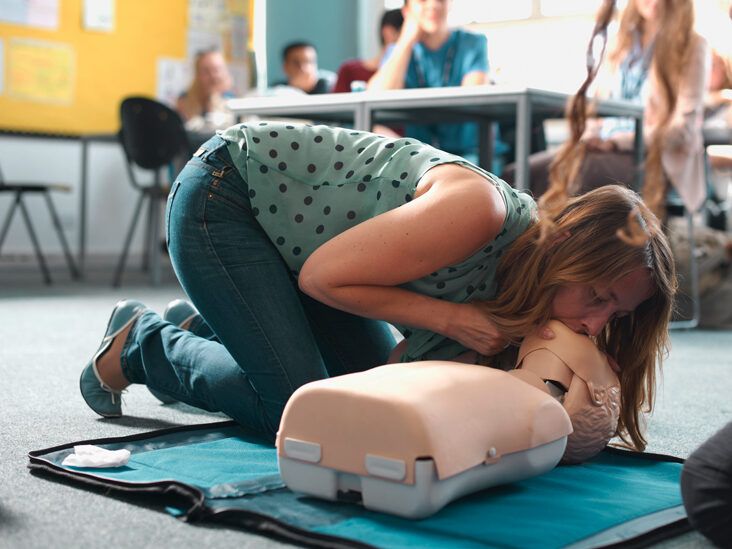Table of Contents
Knowing what to do in emergencies can be the difference between saving someone’s life and reacting way too late. The majority of us are not medical professionals, but that does not mean that we shouldn’t learn how to react when someone needs help.
In this article, we are going to give you some first aid training tips and we will try and give you basic information on how to do CPR. Use this Saving Lives 101 guide if you want to be prepared no matter where you are and no matter who may need your help.
What Is the Essence of CPR?
Cardiopulmonary Resuscitation, commonly referred to as CPR, is a lifesaving procedure that can be crucial during emergencies, especially when someone’s heartbeat or breathing has ceased.
At its core, cardiac resuscitation seeks to restore blood flow and oxygen to the brain and vital organs by manually pressing on the chest and giving breaths.
In numerous life-threatening situations like cardiac arrest, drowning, or an overdose, cardiopulmonary resuscitation acts as a temporary measure to keep oxygenated blood flowing until more advanced care can be provided.
What Are the Most Important Steps of It?

Administering the kiss of life procedure follows a sequence of steps that are easy to remember by the acronym C-A-B: Compression, Airway, and Breathing. Firstly, lay the person on a firm surface. Begin with chest compressions.
Position yourself with your hands interlocked and press hard and fast on the person’s chest, aiming for a rate of 100-120 compressions per minute. After 30 compressions, check the airway, making sure it’s clear. Next, provide two rescue breaths.
If you’re trained to do so, tilt the head back, pinch the nose, cover their mouth with yours, and blow until you see the chest rise. Then, quickly return to chest compressions. Continue this cycle until emergency services arrive or the person shows signs of life.
Why Do You Need to Get Certified?
Gaining proficiency in mouth-to-mouth resuscitation doesn’t just arise from reading about it or watching online tutorials. Hands-on training is pivotal. Hence, getting certified is essential for those serious about mastering this life-saving skill.
A formal cardiac resuscitation certification class offers a comprehensive curriculum, ensuring that individuals can confidently and effectively administer cardiopulmonary resuscitation when the need arises. Moreover, certification typically involves both theoretical learning and practical sessions, offering an opportunity to practice under professional guidance.
Remember, when you’re certified, not only do you possess the skills, but you also have verification that you’ve been trained to render aid correctly. If you want to know more about the steps you need to take to get certified, then you should visit https://cprcertificationnow.com/products/cpr-first-aid-certification.
How Do You Know When It Is Necessary?

It’s equally as vital to recognize when the kiss of life procedure should be administered as it is to know how to do it. Before initiating CPR, confirm the person is unconscious. Shout their name or shake them gently, but avoid shaking infants.
Check if they’re breathing. Agonal breaths—sporadic, irregular, and shallow breaths—don’t count as effective breathing. If they’re not breathing or only taking agonal breaths and show no signs of life, begin cardiac resuscitation. Acting swiftly is crucial since every passing second can affect the outcome.
What Are the Things You Need to Be Cautious Of?
While mouth-to-mouth resuscitation is a pivotal intervention in saving lives, it’s not without potential complications. Chest compressions, especially when done with great force, can sometimes result in broken ribs.
It’s a risk but one that’s considered necessary given the alternative of a fatal outcome. It’s also essential to ensure the person’s safety. For instance, before starting cardiopulmonary resuscitation, make sure the individual is in a safe environment.
If they collapse due to a hazardous environment like a gas leak or fire, move them to safety first. Lastly, always use a barrier device like a mask or a face shield when giving rescue breaths, reducing the risk of transmitting infectious diseases.
Remember that You Need to Pay Attention to The Newest Guidelines

CPR guidelines aren’t static. They’ve evolved over the years, with every change aiming to increase the effectiveness of the resuscitation process. These changes stem from extensive research and clinical studies.
It’s vital, therefore, for those certified to keep abreast with the latest guidelines and consider periodic retraining. By doing so, they ensure that they’re always ready to offer the best possible care during emergencies.
Know that CPR May Come with An Emotional Toll
It’s not just the physical act of performing cardiac resuscitation that can be challenging; the emotional and psychological toll it can take on someone, especially if it’s a loved one or known acquaintance, can be considerable.
Being prepared mentally is just as critical as knowing the correct compression rhythm. It’s essential to understand that while cardiopulmonary resuscitation can be a lifesaver, it’s not always successful, and the outcome can sometimes be beyond one’s control.
It’s crucial to manage one’s expectations and emotions, focusing on the act’s importance and the hope it brings, regardless of the outcome.
Pay Attention to Other First Aid Techniques as Well
While the kiss of life procedure stands out as a primary life-saving technique, it’s just one component of a comprehensive first-aid approach. Learning other first aid skills, such as managing choking, controlling bleeding, or handling burns, can be just as pivotal.
In many emergencies, the sequence in which aid is rendered can determine the outcome. As such, a holistic understanding of first aid, combined with expertise in mouth-to-mouth resuscitation, equips individuals to handle a myriad of emergencies effectively.
What Is the Future of This First-Aid Technique?

As science advances, so does our understanding of the human body and the most effective resuscitation techniques. Innovations like mechanical CPR devices are on the horizon.
These tools aim to provide consistent, high-quality chest compressions in situations where manual compressions might be challenging, such as during transportation. Additionally, ongoing research into the optimal combination of compression depth, rate, and rescue breaths will inevitably lead to further refinements in cardiopulmonary resuscitation guidelines.
Staying informed about these advancements ensures that you’re always equipped with the latest knowledge and techniques.
Mastering the kiss of life procedure is akin to having a superpower — the power to give someone a fighting chance at life. But, like all powers, it requires responsibility, training, and continuous learning.
Whether you’re a layperson wanting to equip yourself with essential skills or a professional in the healthcare sector, the importance of understanding cardiac resuscitation cannot be overstated.
By getting certified, keeping updated with the latest guidelines, and integrating mouth-to-mouth resuscitation in a broader first-aid framework, you’re not just preparing yourself. You’re preparing to be a beacon of hope in someone’s most desperate moments.

